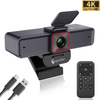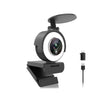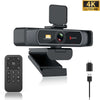
If you don’t have a 1080p webcam on you during your next Teams or Zoom call, you’re missing out. Why spend money on hair, makeup, and skincare, then use a poor 720p webcam in front of friends and colleagues? Our picks for the best webcams mean that you can look your best, for less.
In the era of remote work and virtual communication, having a good webcam is as essential as having a strong internet connection. From professional video calls to streaming and content creation, the right webcam can drastically enhance your online interactions. But with the wide array of webcams available, it's not always easy to choose the one that best fits your needs. In this guide, we’ll take you through the key features and considerations to help you make an informed decision.
Understand Your Needs
Begin by assessing what you’ll primarily use the webcam for. If you're a live streamer, you might prioritize a higher resolution and frame rate for crisp, fluid images. On the other hand, if you’re looking for a webcam for basic conference calls, then perhaps a stable connection and clear audio might be your priority.
Resolution and Quality
As with a monitor or television, resolution is defined as the clarity of a digital image or video. Measured in pixel width by pixel height, here are the three most common webcam resolutions, from lowest to highest resolution:
1280 x 720 pixels/720p (HD Ready)
1920 x 1080 pixels/1080p (Full HD)
Frame Rate
The frame rate dictates how smooth the video output will be. Frame rate, sometimes referred to as frames per second (fps), is a measure of how many pictures your webcam is taking a second. Since video is a collection of pictures, higher fps gives you more fluid recording and streaming and less choppiness. A higher fps, such as 60 fps, can provide a much smoother image, which is vital for recording movements or streaming.

Field of View (FOV)
Field of view (FOV) is the angle of the triangular area that your camera captures.
For most uses, wide FOVs of 100° or above are optimal because they offer greater possibilities for communication and expression.
However, you may prefer a narrow FOV between 70°–85° if you use your webcam in a shared, small, or cluttered environment, or if you use your camera from a distance, such as across a living room or conference table.
A comfortable middle ground may be a zoomable webcam or a webcam with a moderate 85°–100° FOV.

Quality of Built-In Microphones
A feature that often doesn't get the attention it deserves is the built-in microphone in webcams. A quality internal microphone can streamline your setup, doing away with the need for extra equipment like unwieldy headsets or additional microphones that contribute to a cluttered desk. Many advanced webcams come equipped with dual microphones, enhancing the audio experience for the listener with a richer, more lifelike stereo sound.
However, it's important to note that while built-in microphones are convenient, they typically have a wider pickup range, which means they may inadvertently capture ambient room noises. This can be less than ideal in a bustling environment or a shared workspace where background noise is unavoidable. For content creators or professionals seeking crystal-clear audio quality, an external USB microphone or a dedicated headset may still be the preferred choice to ensure the highest level of sound fidelity.

Autofocus Capabilities
The autofocus feature in webcams brings convenience and clarity to your video experience, automatically adjusting to keep the subject in sharp focus. It's particularly adept at adapting to movements, ensuring that you remain the center of attention even when you're animated or showcasing something up close — perfect for those days when you want to highlight a new hairstyle or demonstrate a product.

With Ring Light
Ring light-equipped webcams offer an all-in-one solution for enhanced video clarity in low-light conditions, eliminating the need for additional lighting equipment. The basic models provide a spectrum of neutral to cool lighting options across three distinct brightness levels, accommodating various ambient conditions. For more nuanced control, advanced webcams deliver adjustable color temperature settings and seamless brightness variation, allowing you to fine-tune the lighting to match your environment perfectly or to create a specific mood.

With Privacy Cover
A webcam's privacy cover is a small, but crucial, component that ensures your personal space remains confidential when the camera is not in use. It acts as a physical barrier, preventing any potential unauthorized recording or spying, which is particularly vital in today's digital age where privacy concerns are at an all-time high. With a simple slide or flip, you can control when your webcam is exposed, providing peace of mind and an extra layer of security. Whether it's for personal use or in a professional setting, a privacy cover is an essential feature for anyone looking to safeguard their privacy against digital intrusion.

Conclusion
Taking the time to research and understand webcam specifications will pay off by enhancing your virtual presence. Remember, the best webcam for you is one that fits your specific needs and budget.
Incorporate a strong call to action at the end, such as inviting readers to check out your top webcam picks or to leave comments with their own recommendations and experiences.
FAQ
1.Do you need Wi-Fi for a webcam?
Yes and no. These webcams all connect to your computer directly, via a USB port, and you can record video from them while offline. Your computer will then need to be connected to either ethernet or to Wi-Fi for you to be able to chat with a friend or business partner, however.
2.Can a webcam work without a computer?
Some webcams can work without a computer, but not all of them. USB webcams, featured here, connect via USB to a computer and require it to operate. USB webcams are most often those used for video chat or live streaming from your computer on websites such as Twitch.
IP webcams however, can connect directly to a network, router, or modem and do not require a computer at all in order to work. IP webcams are most often used as security cameras or for live feeds that upload directly to the cloud. Those are separate products, however, and not the same webcams we’re talking about here.
3.How do I connect my webcam to the internet?
For USB webcams, it will be as simple as plugging the camera into your computer’s USB port, and then connecting to the internet via your computer.
4.What software do I need to connect my webcam?
Technically, most webcams are plug and play, so you should simply be able to connect them to your PC to get them to work. Many, however, require their own software utilities to be installed to take advantage of specific features and to facilitate automatic updates. To actually use your webcam in a conference call, however, you’ll need to use Zoom, Microsoft Teams, Google Meet, or another videoconferencing app. Make sure you enter the app’s settings menu and select the webcam’s camera and microphone to provide the audio and video for your call.








 Angetube 913Ai
Angetube 913Ai
 Angetube 866MAX
Angetube 866MAX
 Angetube 914Max
Angetube 914Max
 PTZ 4K 871Ai
PTZ 4K 871Ai
 Angetube @30fps 863Plus
Angetube @30fps 863Plus
 Angetube @60FPS 873Ai
Angetube @60FPS 873Ai
 Angetube 967Pro
Angetube 967Pro
 Angetube 967
Angetube 967
 Angetube 862Pro
Angetube 862Pro
 Angetube 920
Angetube 920
 Angetube 963
Angetube 963
 Angetube 962
Angetube 962
 Angetube 925c
Angetube 925c
 Angetube 628
Angetube 628
 Smart Notebook
Smart Notebook
 862Pro
862Pro
 863PLUS
863PLUS


